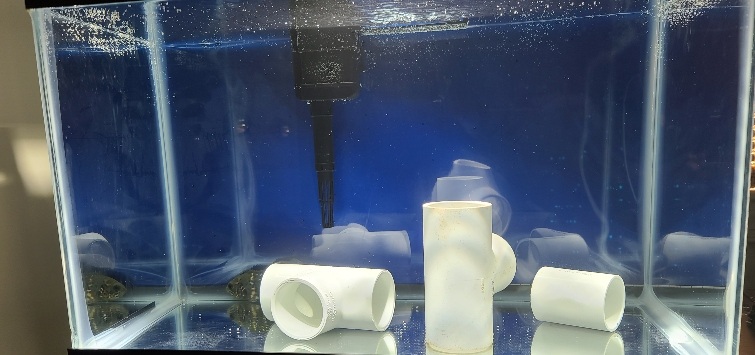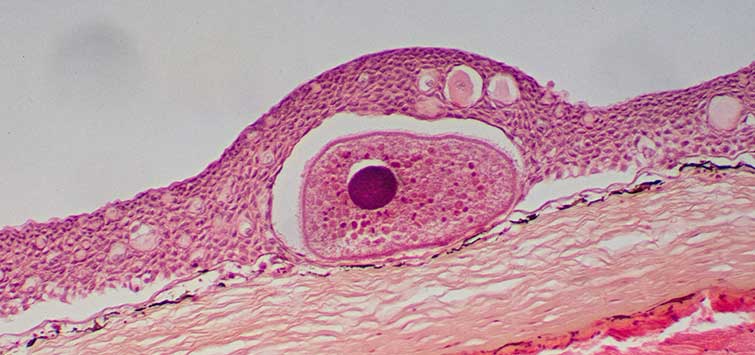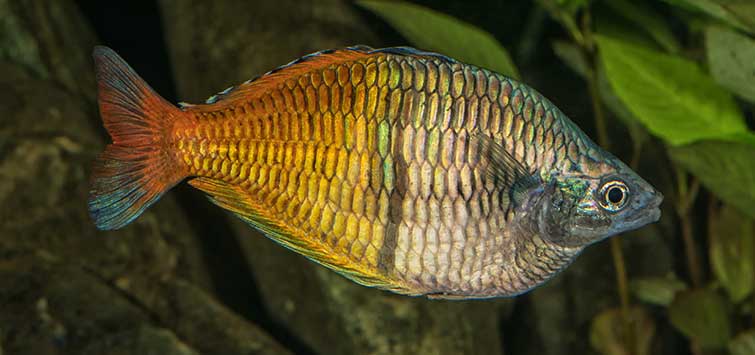The Skeptical Fishkeeper: Quarantine
Author: Laura Muha
The Skeptical Fishkeeper: November 2007
The idea for this month’s column came to me last summer at a small-town fair, as I watched my 7-year-old nephew make a beeline for the “Win a Goldfish!” booth.
The object of the game was to land a ping-pong ball in any of a bunch of fishbowls clustered on a table, and if you succeeded you got to take the fish in that bowl home.
Animal-rights activists have been trying to ban this fairground staple for years, but that’s not an issue I want to get into here. Suffice to say that their arguments were lost on a small boy who’s been passionate about fish since he was a toddler, and who already has two tanks of his own. In his eyes, the game presented a wonderful opportunity to add to his beloved collection without having to spend his hard-earned allowance to do it.
The problem that didn’t occur to Ben, but definitely occurred to me, was that neither of the tanks he had at home was a quarantine tank. So if he were to win a fish, it would be swimming around with his established fish a mere hour or two later. And that, I tried to tell to my brother (Ben’s dad), was a bad idea.
“Fish can carry lots of diseases,” I explained, as Ben lobbed a ping-pong ball at the fishbowls.
Clink! It bounced off the rim of one of them and tumbled to the floor.
“Even if they look fine, the stress of being moved from one environment to another can bring them out a latent problem, so before you add a new one to an established tank you really should quarantine it,” I said.
Clink!—another ball ricocheted off a bowl.
“Otherwise, you could wind up infecting all of your other fish.”
My brother nodded, probably less because I’d impressed upon him the importance of quarantine than because he saw it as yet another reason to make sure the fish mania didn’t get out of control in his house the way it has in mine.
“Ben—” he started to say. But just then my nephew took aim, a determined look in his eye. He flicked his wrist and, as if in slow motion, the ball arced through the air and, plunk!, landed in a bowl containing a skittish-looking goldfish.
“Yay!” Ben shouted.
He had himself a fish, and I had myself a column.
Why Quarantine a New Fish?
Judging from discussions I’ve had with other fishkeepers and debates I’ve seen on Internet fish sites, many hobbyists view quarantining new fish the way they do eating right. They know it’s something they should do, but, all too often, don’t.
For some, it’s because they’re too impatient to wait out a quarantine period; they want that new fish in their tank now! For others, it’s an unwillingness to invest money and time in a tank they’re not going to use regularly. Some hobbyists seem to think the concept of quarantine is overblown; a disease outbreak, they believe, is something that happens to other people’s tanks, never their own. And of course there’s the unexpected acquisition—the fish that, say, your nephew wins at the fair, or the species we’ve been searching for that suddenly appears in our local fish shop. If we don’t buy it now, we rationalize, who knows when we’ll find it again—and, besides, it looks healthy. So why not take our chances?
To answer that question, here’s a horror story courtesy of Koran Weston, a fishkeeper from British Columbia, Canada, who has three freshwater community tanks: a 75 gallon, a 25 gallon, and a 10 gallon.
One day she got a hankering for a paradise fish. So she picked one that looked plump and healthy and added it to her 10-gallon tank.
Everything went fine for about a month—until the day that Weston noticed a red worm protruding from the vent of that plump, healthy-looking paradise fish. It was a camallanus worm, a nasty and contagious nematode that lives in the intestines of fish. It hadn’t been evident when she bought the fish, probably because there are several stages to the parasite’s lifecycle, and only the last one is visible to the naked eye. But soon it was wreaking havoc in all of her tanks. By the time the outbreak was under control three months later, she said, she’d spent some $200 on medication and lost dozens of fish, including her three beloved angelfish.
“Now I quarantine all fish for six weeks. No exceptions,” said Weston, who has a 5-gallon tank specifically for that purpose.
That’s music to the ears of Dr. Tim Miller-Morgan, an aquatic veterinarian who runs the ornamental fish health program of the Oregon Extension Sea Grant. “I’m constantly ranting about quarantine,” Miller-Morgan said. “It’s very underutilized, and yet it’s just essential.”
He explained that even healthy fish carry some pathogens; the reason they don’t get sick is because their immune systems are able to keep them in check. But when fish are placed under stress—as they are when they’re bounced from fish farm to wholesaler to retailer to a hobbyist’s tank—their resistance often drops, and pathogens can gain the upper hand.
How Long Is Long Enough?
How long it takes for this to happen, though, can depend on a number of factors, including the species of fish, the pathogen, and the water conditions both are living in. For instance, at temperature of 75° to 79°F, the life cycle of the parasite that causes ich is about 48 hours, while at 60°F, it can take nearly a week to complete.
And that’s where quarantine starts to get complicated. If every pathogen has its own life cycle, and the life cycle is often dependent on water conditions such as temperature, then how do you know how long of a quarantine is long enough? Is two weeks adequate, as some fishkeepers insist? Or three weeks? A month? Six weeks?
“There is little scientific evidence on what is the ‘ideal’ period,” admits Dr. Edward Noga, author of the textbook Fish Disease: Diagnosis and Treatment (Blackwell Publishing, 2000) and a professor of aquatic medicine at North Carolina State University’s veterinary college. “In general, a three- to four-week quarantine period is considered good, but [it] depends upon the particular pathogens that pose a risk to the population.”
Miller-Morgan said he knows some koi hobbyists who quarantine a new fish for a full year before adding it to a pond with established stock—“They don’t feel comfortable until they put it through a year of temperature fluctuations,” he explained—but in general he thinks a month is a reasonable amount of time to isolate new arrivals.
“Quarantine isn’t just to prevent disease from getting into the system,” he said. “It also lets the fish acclimate to new surroundings, a new system, new food. It gives them a chance to settle down and gives their immune system a chance to recuperate [from the stress of transport].”
And by the way, while most of us tend to think the point of quarantine is to protect our established stock, the reverse can also be true. The fish in your tank are used to certain pathogens that are already there, and have resistance to them, but a new fish added to that tank might not, Miller-Morgan explained. By isolating it, then adding small quantities of water from the established tank to the quarantine tank over a period of several months, you’ll give the new fish time the opportunity to build up resistance to any pathogens that might be present in that water.
Is an Ounce of Prevention Worth a Pound of Cure?
Many of the professional aquarists I’ve talked to over the years go a step further, routinely medicating quarantined fish for a host of diseases, even if there’s no evidence those diseases are present. Some also give new freshwater fish a salt dip, and new marine fish a freshwater dip, to kill off parasites before placing them in quarantine.
But that’s not something most home aquarists should be doing for several reasons, and Miller-Morgan and Noga agree. First, both pointed out that professionals usually use medications based on an in-depth knowledge of both the species they’re dealing with and the kind of pathogens that species is prone to; they also understand the impact of medications on both organisms. Home aquarists, however, rarely have that kind of knowledge.
In addition, adding medications to tank water is in itself a stressor to fish because it changes the concentration of dissolved solids in the water, which in turn affects the fish’s osmoregulatory processes.
And lastly, said Miller-Morgan, treating for diseases the fish may not have can ultimately lead to medication-resistant pathogens, which can create a much bigger problem down the line.
Quarantine Basics
So what would a good quarantine system look like? The size of the tank will vary according to the sorts of fish you keep—larger or fast-swimming fish, for instance, require larger quarantine tanks than smaller, quieter fish. But beyond that, simpler is better; keep the lighting low—it keeps fish calmer—and make sure that anything you put into the tank is easily sterilized.
That means opting for things like plastic plants and PVC pipe (added not to make the tank look beautiful, but to make the fish feel secure) over real or silk plants. “And nothing porous, like lava rock, because pathogens can get into the pores,” Miller-Morgan said. He also recommends skipping the substrate, since a barebottom tank is easier to keep clean and also to sterilize later. And, he adds, make sure that any nets and siphons used in a quarantine system are kept separate; using them in an established tank is a good way to spread pathogens.
The only “problem” that has to be addressed with any tank that isn’t in constant use is how to keep the biofilter going. Some people keep a few fish in them, transferring them to their main tank when the quarantine tank is needed for new arrivals. You can also keep the biofilters running in a fish-free quarantine tank by adding small amounts of ammonia.
Personally, I keep my quarantine tanks empty between use; when I need them, I instant-cycle them by pulling filter pads from my established tanks and putting them into the quarantine-tank filters. (Alternatively, you can keep an extra box filter running in an established tank, ready to move to a quarantine tank when needed.)
If you need to sterilize a quarantine tank, Miller-Morgan says that bleach, at a concentration of 200 ppm (or 200 mg/liter of water), will do a great job. However, he cautions, organics do cause bleach to break down, so make sure you rinse everything thoroughly before using the bleach, or it won’t be as effective.
The Goldfish Saga Continues
To close this month’s column, I thought I’d return to the saga of my nephew and his country-fair goldfish.
I’d like to be able to tell you that Aunt Laura’s wisdom prevailed that evening at the fair, and that I managed to talk him (or rather, his parents) into stopping at the local pet shop for a quarantine tank on the way home. I did not.
Rather, the fish went directly into my nephew’s 30-gallon goldfish tank along with his three established fish (although I did manage to work in a lesson on acclimation techniques). I did, however, suggest to my brother that he do a series of partial water changes over the course of the next week to reduce any free-swimming parasites that might be in the water.
As I write this, several weeks have passed and so far neither the new fish nor the originals are showing any signs of a problem. So my nephew could well be lucky.
But I also know that good luck rarely lasts forever, and if Ben is serious about fishkeeping, which he seems to be, there will be many finned additions to his collection in the years to come.
So I’ve been thinking: His birthday is coming up. Wouldn’t a quarantine tank make a perfect gift?
See the full article on TFH Digital http://www.tfhdigital.com/tfh/200711/#pg58

.png?h=595&iar=0&w=2781&hash=5FD5E69473BCC22199FBFA2FB71B6033)



